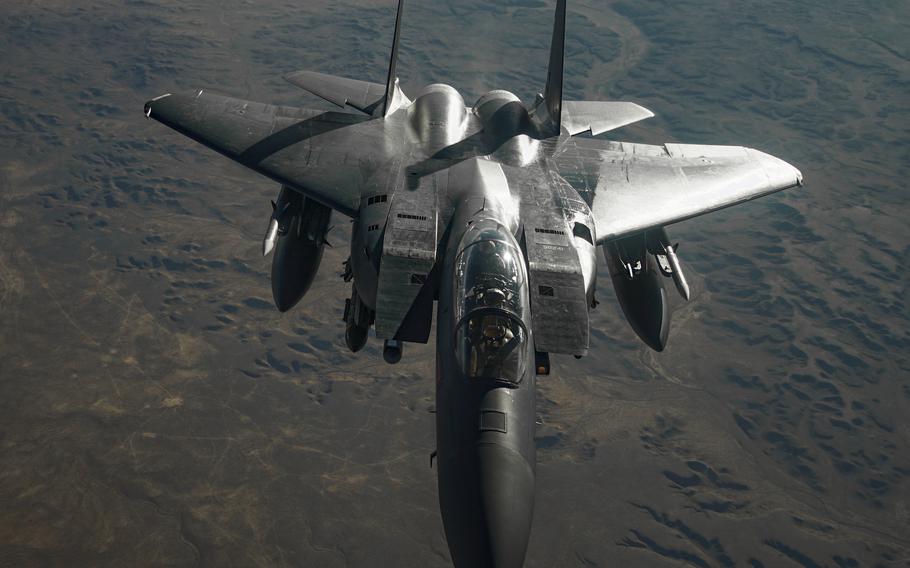
An Air Force F-15E Strike Eagle prepares to depart after receiving fuel from a KC-135 Stratotanker during a mission supporting Combined Joint Task Force - Operation Inherent Resolve over the U.S. Central Command area of responsibility on Feb. 9, 2021. (Taylor Harrison/Air Force)
WASHINGTON — Rocket fire that targeted U.S. and coalition forces in Syria on Friday was the latest in a series of retaliations that included U.S. airstrikes a day earlier on Iran-linked sites and a drone attack that killed an American contractor and wounded other U.S. personnel, defense officials said.
The strike on Friday included 10 rockets that were aimed at Mission Support Site Green Village, a compound in northeastern Syria that houses U.S. and allied forces. The attack was a response to two U.S. airstrikes on other facilities in Syria used by forces linked to Iran’s Islamic Revolutionary Guard Corps, according to defense officials.
“The attack resulted in no injuries to U.S. or coalition personnel and no damage to equipment or facilities,” Air Force Brig. Gen. Pat Ryder, the Pentagon’s top spokesperson, told reporters Friday. “Our focus in Syria is on the ‘defeat ISIS mission’ and that will remain our focus.”
U.S. Central Command said one of the rockets missed its target and hit a civilian house nearby, slightly injuring two women and two children there.
“This kind of indiscriminate rocket attack places not only our forces and coalition forces at risk, but also jeopardizes the local civilian population as well as the security and stability of Syria and the entire region,” Army Col. Joe Buccino, a CENTCOM spokesman, said in a statement Friday. “As President [Joe] Biden has made clear, we will take all necessary measures to defend our people and will always respond at a time and place of our choosing.”
The series of attacks began Thursday when a drone crashed into a U.S. and coalition base in Al-Hasakah, Syria. Ryder said U.S. officials are confident the drone was made by Iran and supplied to proxy forces in Syria who crashed it into the base. An American contractor was killed in the attack and five U.S. troops and another contractor were hurt. Al-Hasakah is about 95 miles northeast of Green Village.
A few hours later, the U.S. sent two F-15 fighter jets to blow up two facilities in east-central Syria in the Deir el-Zour area that the Pentagon said were frequented by Iran’s Islamic Revolutionary Guards Corps. The rocket attack followed on Friday.
Press TV, a state-run Iranian news agency, claimed in a report Friday that the U.S. airstrikes hit a “rural development center and grain center” – not a military post aligned with the IRGC.
U.S. officials have not detailed the extent of the troops’ injuries in the drone attack, but CNN reported they were all in stable condition. The Syrian Observatory for Human Rights – a British-based group that monitors human rights abuses in Syria – said the U.S. airstrikes killed several “Iranian-backed militiamen.”
Ryder said Friday that the U.S. does not seek confrontation with Iran, which has had adversarial relations with the United States and Israel for decades. The Islamic republic often uses proxy fighters to strike targets across the Middle East and Africa. Ryder declined to say whether U.S. officials might respond with another retaliatory strike.
“We don’t seek escalation with Iran,” he said. “But the strikes we took [Thursday] night were intended to send a very clear message, that we will take the protection of our personnel seriously and that we will respond quickly and decisively if they are threatened.”
“We will always reserve the right to respond appropriately,” he added.
CENTCOM has said there are roughly 900 American troops stationed in Syria and 2,500 in Iraq, who are there mostly to prevent a resurgence of terrorism in those countries, especially the Islamic State terrorist group, known as ISIS. The Defense Department has about 6,500 contractors in Syria and Iraq.
Military officials are still investigating the strikes against the U.S. personnel, Ryder said.
A New York Times report said the air-defense system at the coalition base in Al-Hasakah wasn’t functioning. Ryder said that’s also being explored.
“U.S. Central Command will conduct a review to assess what happened and take a look at what, if any, other type of mitigating actions need to be taken,” he said. “But it would obviously be premature to talk about that.”
The United States and Iran haven’t had formal diplomatic relations since the takeover of the U.S. Embassy in Tehran and the country’s Islamic revolution in 1979. The Iranian government, however, regularly keeps up a steady stream of criticism toward the U.S. and Israel and has been taking steps for years to develop a nuclear weapon.
Syria has been devastated by civil war since 2011. Iran and Russia have supported the regime of Syrian President Bashar Assad. The United States has supported groups opposed to Assad’s government, particularly the semi-autonomous region in the northeast and a collection of militias and rebels known as the Syrian Democratic Forces.
“This is a dangerous part of the world. The work we do is inherently dangerous,” Ryder said.
Stars and Stripes reporter J.P. Lawrence contributed to this report.